North Berwick
| North Berwick | |
| East Lothian | |
|---|---|
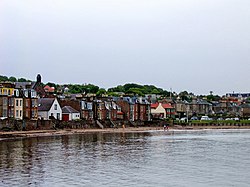 Shoreline at North Berwick | |
| Location | |
| Grid reference: | NT555855 |
| Location: | 55°58’48"N, 2°46’48"W |
| Data | |
| Population: | 6,223 |
| Post town: | North Berwick |
| Postcode: | EH39 |
| Dialling code: | 01620 |
| Local Government | |
| Council: | East Lothian |
| Parliamentary constituency: |
East Lothian |
The royal burgh of North Berwick is a seaside town in East Lothian. It stands on the south shore of the Firth of Forth, some 25 miles east of Edinburgh.
North Berwick became a fashionable holiday resort in the 19th century because of its two sandy bays, the East (or Milsey) Bay and the West Bay, and continues to attract holiday makers to this day. Golf courses at the ends of each bay are open to visitors.
A ferry has in recent years been established sailing during the summer between North Berwick and Anstruther in Fife. This is the reinstatement of an ancient route which used to take pilgrims to Fife on the way to St Andrews.
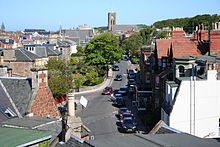
The name "Berwick" is from the Old English language. Berewic means "barley (bere) farmstead". The word "North" was applied to distinguish this Berwick from Berwick-upon-Tweed, which throughout the Middle Ages the Scots called South Berwick. It was recorded as Northberwyk in 1250.
Islands
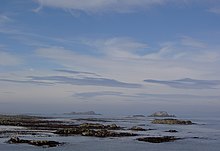
Several of the islands of the Forth are near the town and visible from North Berwick, for example Fidra, The Lamb, Craigleith and Bass Rock.
Bass Rock is barely accessible for much of the year, requiring calm seas and was formerly a feared prison island. Now deserted by man, it hosts a thriving colony of birds, including puffins, gannets and other seabirds. The Bass Rock appears white, but this is due largely to the gannets and their guano that cover much of its surface. The seabirds of the Bass Rock themselves can be observed at close range through remote cameras operated from the recently developed Scottish Seabird Centre near the harbour.
History
On the south of Berwick Law there is evidence of at least eighteen hut circles, rich middens and a field system dating from 2,000 years ago.
Excavations have shown there was activity at the harbour area from as early as the 8th century. The current North Berwick Harbour though was built in the 12th century, and for 500 years there was a ferry crossing to Earlsferry, near Elie in Fife. This journey was popular with pilgrims to St Andrews
The "Auld Kirk Green" at the harbour was used for gatherings by the accused in the North Berwick Witch Trials. A legend has it that "Satan himself" attended a ritual there in 1590, although it is more likely that Satan was "played" by Francis Stewart Hepburn, 5th Earl of Bothwell. During the 16th century at least 70 people were implicated in the Witch Trials, and the events inspired works such as Burns' "Tam o' Shanter" and "The Thirteenth Member" by Mollie Hunter. One of the most famous Witch trials at North Berwick was of the woman named Agnes Sampson. She was accused of making a potion to make the storms rough as King James VI was sailing home from Denmark with his new wife, Anne of Denmark. The trial took place in 1591 and King James was there himself. Sampson was tortured to confess and then burned at the stake.
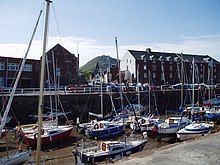
In the Middle Ages repeated invasions led to the construction of nearby Tantallon Castle. St Mary's Priory was built at North Berwick, which remained until the Reformation.
North Berwick remained a quiet port and fishing village until the 19th century.
The late 19th century saw North Berwick's discovery as a holiday destination. The railway brought increased visitor number and expansion in the town. Soon it was to develop holiday facilities and golf courses, bringing a new prosperity to the town. North Berwick remains a popular holiday destination.
Attractions
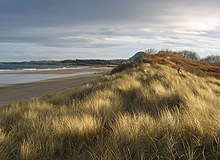
- Boat trips to the Bass Rock, Fidra and other islands.
- The Scottish Seabird Centre - Visitor centre about seabirds found on Bass Rock and elsewhere.
- North Berwick Law - A 613 foot volcanic hill which rises above the town, with a Napoleonic era signal station. (The whale's jawbone arch at the summit is a fibreglass replica replacing an original whale's jawbone arch which collapsed in June 2005.)
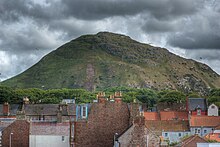
North Berwick Law seen from the seafront of North Berwick - Beaches - One of North Berwick's main attractions, the beaches have golden sands and rocks, and a tide-filled boating pond/paddling pool on the East Sands.
- Seacliff. Just to the east of the town, an entry fee is charged at this private and largely unspoilt beach and estate.
- Golf - There are two golf courses in the town, the West Links and the Glen, or East Links, and numerous others in the surrounding area. There are also two 18-hole putting greens and a Golfing Heritage Trial to follow through the town.
- Tennis - Venue for the annual East Lothian Open Tennis Tournament.
- The East Lothian Yacht Club hosts many national and international sailing events.
- The John Muir Way, the East Lothian coastal path, passes through the town.
- Tantallon Castle, a mostly ruined 14th-century fortress in the care of Historic Scotland, is 3 miles east of North Berwick.
Robert Louis Stevenson
Robert Louis Stevenson (1850–1894), spent many holidays in the town as a child and young man. His father, Thomas Stevenson the engineer and lighthouse builder took his family to stay in various locations in the town. The island of Fidra is said to be the original inspiration for Stevenson's novel Treasure Island, and much of his novel Catriona (the sequel to Kidnapped) is set in and around North Berwick.
References
- "Census 2001". Population figures. http://www.eastlothian.gov.uk/content/0,1094,121,00.html. Retrieved August 17, 2005.
- Town History